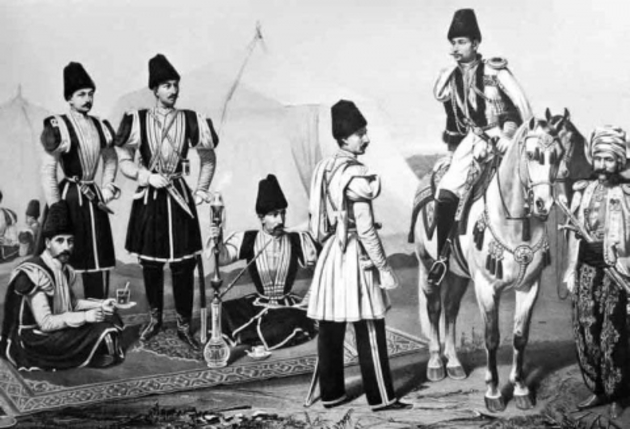Author: VK
After some regions of the Caucasus had joined the Russian Empire in the 1800-1810s, the necessity appeared to integrate new residents and effectively involve them in settling tasks important for the whole state. It should be noted that the Russian authorities succeeded in this sphere, managing to respect the ethnic, cultural, and social identities of the Caucasus people.
“The tsar obtained dedicated supporters of Russia in the Caucasus; people who shared a pro-Russian political course and saw huge opportunities for the great country. They compare the sizes of their own countries with Russia, the opportunities for their nations with Russia”, historian Yavus Akhmadov says. “Of course, from these people the Russian (in the best sense of the word) political party in the North Caucasus appeared.
In 1836 the Emperor decided to expand the guard of the highlanders. From then on it included representatives of the noble families of the mountainous regions of Dagestan, Azerbaijan and Georgia. However, soon it turned out that it is not so convenient to choose according to the noble status of a family”.
As General Alexander Benkendorf wrote to Emperor Nicholas I, "the choice of people to serve in St. Petersburg only from those peoples that have princes and nobility is inconvenient, because it means that the Nogais that have only sultans and Ossetians and Chechens that have only seniors cannot serve in the guard of the Emperor."
The Emperor could not allow that and soon all the peoples of the Caucasus and Transcaucasia received the right to serve in the guard, regardless of their origin and social background. By the mid-1830s the highlanders stopped being something exotic and did not provoke any particular interest in the society of St. Petersburg. They became integrated into the life of the Russian capital.
Service in the guard lasted for four years. It started with the position of armiger. Then some were promoted to junkers. By the end of their service they became officers. At that point, an ensign was the lowest officer position. Then they could become lieutenants, captains, majors, colonels or even generals, depending on their achievements.
The highlanders from the guard had a good opportunity to interact with the Russian aristocracy. In the time free from military exercises - and they had enough of it - they learned the Russian language, went to theatres and balls and tried to participate in the social life and scandals as much as their skills and talents would allow. All this was causing a lot of troubles to Benkendorf.
“For example, one of the officers, Sultan Kazy-Girey, mastered the Russian language very quickly. As a result of this he eventually wrote an essay entitled "The Valley of Azhigutay" that Pushkin liked so much it was even published in the journal "Sovremennik", Yavus Akhmadov says. “In his introduction to the publication, Pushkin noted: "This is an unexpected development in our literature. A son of the semi-wild Caucasus enters the ranks of our writers; a Circassian writes in Russian fluently, powerfully and beautifully." However, Benkendorf and the imperial court got a very different impression from this essay, with its liking of the free highlanders. The reaction of Benkendorf was quick and harsh. On April 15th 1836 he wrote Pushkin the following letter: "Dear Alexander Sergeyevich, I am asking you not to publish in your journal works by members of the Caucasian-Highlander squadron without my preliminary permission."
Soon after the problem with the journal of Pushkin, he had to face a theatrical scandal. Petersburg newspapers were writing with overt pleasure about a scandal in the Alexander Theatre: "A member of the Caucasian-Highlander squadron, Alkhas Sheretlukov, was sitting in the first row with his drunken friends. The play was a drama in which the main heroine had to die in a struggle with obstacles. However, Sheretlukov and his friends were against it and were constantly making ambiguous comments towards the actors. Sheretlukov intended to save the main actress, Ms. Shelikhova, and marry her. The misbehaviour became so unbearable that the performance was stopped."
This became known to the police and the Emperor himself. Chief of gendarmerie Benkendorf ordered stricter punishments for the officers while the guilty highlander was exiled”.
In May 1837 the commander of the highlander squadron, Khan-Girey, arrived in the North Caucasus on a special mission. He had to prepare for the visit of Nicholas I to the Caucasus and meet with Imam Shamil, who was a leader of the highlanders in Chechnya and Dagestan. It was just two years since Shamil had united the highlanders. They had a kind of theocratic state, with the imam at its the head, its own army, currency, its own court and executive power. In his letters to the Emperor, Shamil claimed that "as long as he is alive, he [the Emperor] will always find in him a devoted and faithful servant of the Russian government." Yet the mission of Khan-Girey failed: Shamil refused to go to Tiflis to meet Nicholas I and continued his resistance to the Russian army.
Imam Shamil introduced some popular military and political measures. He abolished slavery, although he did not know that Russia still had serfdom. However, when the soldiers of the tsarist army learned that Shamil had abolished serfdom, many of them left the army and voluntarily joined his army. So there were many more volunteers in the army of Shamil after the abolition of slavery than before.
In the winter of 1838 the Russian army started a constant war against Shamil. His attempts to attack Russian fortress in Avaria failed. 45 of the mountain princes and rulers joined the Russian army in the war against Shamil and send a 3000-soldier regiment. On August 22nd 1839, after a long siege, the citadel of Shamil, Akhulgo, was taken. According to the chronicle, Shamil really wanted to die in the struggle. But this could happen only according to the will of Allah. For three days Shamil and his supporters hid in the caves and then left for Chechnya. The end of the war was still very far away and Emperor Nicholas I continued to reinforce his highland guard. The year 1840 was unsuccessful for the highlanders' squadron - four of its members fled St. Petersburg and joined the army of Shamil.
To be continued
In preparing the article we used films by NTV "Caucasians in Russian wars" and "Horsemen of the Emperor" from the series of documentaries on the history of national units from the North Caucasus in Tsarist, Soviet and modern Russian Army and the role of the representatives of the Caucasian peoples in the protection of the country, as well as the interview of Rudolf Ivanov to historical and analytical portal of the Center of History of the Caucasus at the Institute for Public Policy Research "Azer-Globe".






